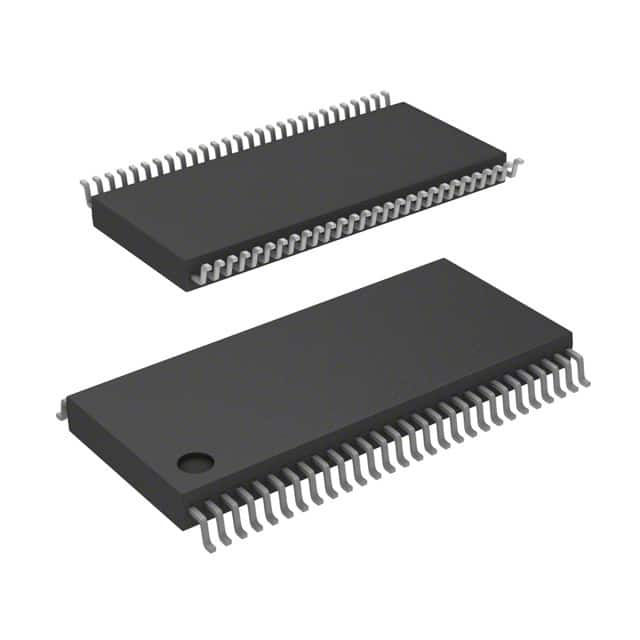Viz Specifikace pro podrobnosti o produktu.

Encyclopedia Entry: 74FCT16501ATPAG
Product Overview
- Category: Integrated Circuit (IC)
- Use: Data Storage and Transfer
- Characteristics: High-Speed, 16-Bit Universal Bus Transceiver
- Package: TSSOP (Thin Shrink Small Outline Package)
- Essence: Bidirectional Buffer/Transceiver with 3-State Outputs
- Packaging/Quantity: Tape and Reel, 2500 units per reel
Specifications
- Logic Family: FCT
- Number of Bits: 16
- Supply Voltage: 4.5V to 5.5V
- Input/Output Type: TTL-Compatible
- Operating Temperature Range: -40°C to +85°C
- Propagation Delay: 2.5ns (Max)
- Output Drive Capability: ±24mA
Pin Configuration
The 74FCT16501ATPAG has a total of 48 pins arranged as follows:
+---------------------+
A1 |1 48| VCC
B1 |2 47| B2
A2 |3 46| GND
B3 |4 45| B4
A4 |5 44| A3
B5 |6 43| B6
A6 |7 42| A5
B7 |8 41| B8
A8 |9 40| A7
B9 |10 39| B10
A10 |11 38| A9
B11 |12 37| B12
A12 |13 36| A11
B13 |14 35| B14
A14 |15 34| A13
B15 |16 33| B16
A16 |17 32| A15
B17 |18 31| B18
A18 |19 30| A17
B19 |20 29| B20
A20 |21 28| A19
B21 |22 27| B22
A22 |23 26| A21
B23 |24 25| B24
+---------------------+
Functional Features
- Bidirectional data transfer between two independent buses
- 3-state outputs for bus isolation
- TTL-compatible inputs and outputs for easy integration with other ICs
- High-speed operation for efficient data transfer
Advantages and Disadvantages
Advantages: - High-speed performance enables rapid data transfer - Bidirectional functionality allows flexible data flow between buses - 3-state outputs provide effective bus isolation
Disadvantages: - Limited to 16-bit data transfer, may not be suitable for larger data sets - Requires external power supply within specified voltage range
Working Principles
The 74FCT16501ATPAG is a bidirectional buffer/transceiver that facilitates data transfer between two independent buses. It operates by receiving input signals from one bus and transmitting them to the other bus, or vice versa. The 3-state outputs allow the device to isolate itself from the buses when necessary, preventing conflicts and ensuring smooth data flow.
Detailed Application Field Plans
The 74FCT16501ATPAG can be utilized in various applications that require high-speed data storage and transfer. Some potential fields of application include: - Data communication systems - Networking equipment - Industrial automation - Automotive electronics - Consumer electronics
Alternative Models
Here are some alternative models that offer similar functionality to the 74FCT16501ATPAG: - SN74LVTH16501DGGR - MC74VHC16501DTR2G - CD74HCT165E
These alternatives can be considered based on specific requirements and compatibility with existing systems.
Word count: 314 words
Seznam 10 běžných otázek a odpovědí souvisejících s aplikací 74FCT16501ATPAG v technických řešeních
Sure! Here are 10 common questions and answers related to the application of 74FCT16501ATPAG in technical solutions:
Q: What is the function of the 74FCT16501ATPAG? A: The 74FCT16501ATPAG is a 16-bit universal bus transceiver with 3-state outputs.
Q: What voltage levels does the 74FCT16501ATPAG support? A: It supports both TTL (5V) and CMOS (3.3V) voltage levels.
Q: Can the 74FCT16501ATPAG be used for bidirectional data transfer? A: Yes, it can be used for bidirectional data transfer between two buses.
Q: What is the maximum operating frequency of the 74FCT16501ATPAG? A: The maximum operating frequency is typically around 200 MHz.
Q: Does the 74FCT16501ATPAG have built-in ESD protection? A: Yes, it has built-in ESD protection on all inputs and outputs.
Q: Can the 74FCT16501ATPAG handle hot-swapping of devices? A: Yes, it has a hot-insertion capability that allows for safe device insertion/removal while the system is powered.
Q: How many control pins does the 74FCT16501ATPAG have? A: It has two control pins - OE (Output Enable) and DIR (Direction).
Q: What is the power supply voltage range for the 74FCT16501ATPAG? A: The recommended power supply voltage range is 4.5V to 5.5V.
Q: Can the 74FCT16501ATPAG be cascaded to increase the number of bits? A: Yes, multiple devices can be cascaded together to increase the number of bits in the bus.
Q: Does the 74FCT16501ATPAG have any special features for noise reduction? A: Yes, it has a built-in Schmitt trigger input that helps reduce noise and improve signal integrity.
Please note that these answers are general and may vary depending on the specific implementation and datasheet of the 74FCT16501ATPAG.

